Title: From Ruptured Pectoral to Recovery: My 4-Month Journey
Posted by Rodney Alford on Sep 23rd 2023
Introduction:
Four months ago, I embarked on a life-altering journey that began with a ruptured pectoral muscle. This injury, which I initially underestimated, turned out to be far more serious than I had ever imagined. Today, I want to share my story of this challenging experience, the surgery that followed, and the ups and downs of my recovery process over the past four months.
The Injury:
My journey into the world of serious injuries began with what seemed like a routine gym session. I had been exclusively using resistance bands in my garage, but that Saturday, I was itching for some traditional iron. It had been several months since I last hit the bench press, and there I was, feeling the echoes of my powerlifting days from years gone by. I loaded up 315 pounds and managed four reps – a feat I hadn't accomplished in over a decade, back in my forties. The band workout I’d been doing not only held my muscles they were making me stronger. Filled with pride and excitement, I set up a camera, determined to capture this moment for my fellow fitness enthusiasts.
But then, it happened. The first rep came crashing down with a deafening BANG! It sounded like a gunshot and a zipper all rolled into one. With the help of my spotter, I managed to rack the weight, though deep down, I knew something was seriously wrong. Despite the pain, I wasn't ready to admit just how serious it might be. I went home, immediately applied ice, and hoped for the best.
To see how it happened click on link below
https://drive.google.com/file/d/11nha9SH9jIde5jfrh...
Over the next few days, the area turned an ominous shade of blue, but I convinced myself that a little ice and some workaround exercises would do the trick. For five long weeks, I soldiered on, waiting for the swelling to subside and still doing pretty much my same training routine. However, as the weeks passed, my upper pec began to sag noticeably below my main chest muscle. It was a disheartening sight, and after conducting some research, I reluctantly concluded that I had torn my pec, though I still couldn't fathom how severe the damage might be.

(morning after injury)
(A side note: If you ever suspect a torn pec, don't hesitate to get an MRI immediately. There's a critical 60-day window for successful reattachment, and I was fast approaching that limit.)
(Before surgery bodyweight 202lbs You can tell how much lower my left pec was from the right)
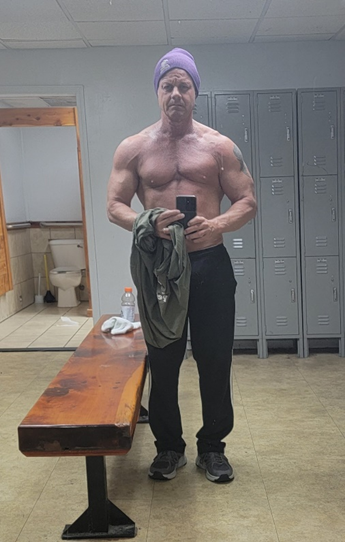
After consulting with a sports medicine specialist and undergoing an MRI, the truth hit me like a ton of bricks. I had not only ruptured my pectoral muscle but also torn it at the pectoral insertion point. The damage was so extensive that there wasn't enough tendon left to reattach. I had torn my upper pectoral. So if it had to happen I was thankful it was the upper pec.
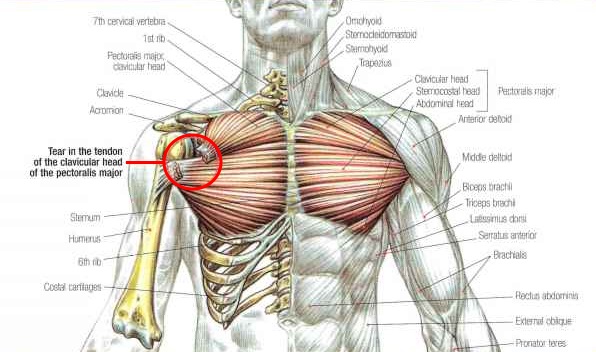
My surgeon Dr. Brian Waterman Wake Forest Orthopedic grim explanation shook me to my core: they would have to use cadaver tissue to create a "taco" of sorts, sandwiching my torn pec and sewing it back together. To secure the other end, they'd employ a button-like device, fastened through the bone in my upper shoulder area. As I left the doctor's office, the weight of the recovery ahead felt almost insurmountable. I was informed that even if I managed to regain normalcy, I was looking at a minimum recovery period of one year to return to normalcy. But Dr. Waterman was super! He didn’t sugar coat it gave me the facts. Dr. Waterman looked in shape and is young. He understood although I have some age on me I still desired aesthetic looking muscle not just functional. He reassured me that it would be possible to not only regain functionality but allow look as if nothing had happened.
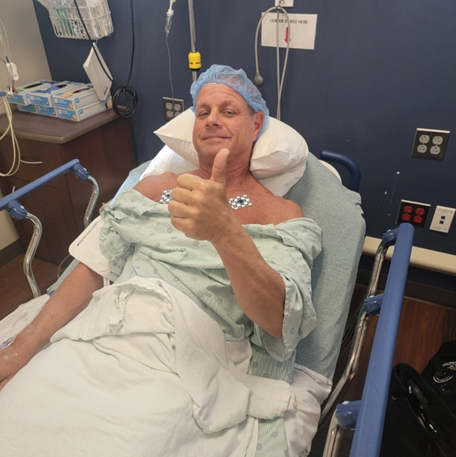
The Surgery (May 17): Almost two months to the day after the fateful incident, I found myself on the operating table. Dr Waterman explanation of the procedure served as a stark reminder of the seriousness of my injury. Surgery wasn't just an option; it was my only hope for reattaching the torn muscle and restoring its function. The gravity of the situation became even more evident during our pre-surgery discussions. With a mix of anxiety and hope for a full recovery, I went under the knife, fully aware that this was just the beginning of a challenging journey.
The surgical team began by administering anesthesia to ensure I remained comfortably unconscious throughout the procedure.
The surgeon then made an incision over the injured pectoral muscle, revealing the extent of the damage. The rupture, There wasn't enough tendon left to reattach it using traditional methods.
To address this challenge, the surgeon turned to a unique solution – a cadaver tendon. This donated tendon tissue would serve as the bridge between the torn ends of my pectoral muscle. Picture it as if they were crafting a delicate sandwich, with the cadaver tendon acting as the filling. The surgical team gently split open the torn pectoral, creating a pocket to accommodate the cadaver tendon.
Next came the meticulous process of sewing the muscle back together, effectively encapsulating the cadaver tendon within the tear. The surgeon's skilled hands worked with precision, ensuring the reconnection was secure and robust. To anchor the other end of the pectoral muscle, they employed a button-like device, which was threaded through the upper shoulder area and secured firmly into the bone. This would provide the necessary stability during the healing process.
Immediate Post-Surgery: Immediately after the surgery, I woke up in the recovery room feeling groggy and in pain. The surgeon had successfully repaired the rupture, but I had a long road ahead. Dr Waterman sewed the tendon extra tight, so I’d have the best possible outcome possible. My arm was immobilized in a sling to allow the muscle to heal properly. The first few days were the most challenging as I had to rely on others for even the simplest tasks.

(pain pilled up had to stop on way home to eat Cuban food)
One Week Post-Surgery: One week in, I was still in considerable pain, but there was a glimmer of hope. I started physical therapy to regain my range of motion and strengthen the surrounding muscles. The first sessions were tough, but I could sense progress.

(One-week post-surgery)
Two Weeks Post-Surgery: By the end of the second week, I was gradually weaning off pain medications, and the physical therapy sessions were becoming slightly less painful. I began to regain some independence in my daily activities, although I still needed assistance for many tasks.
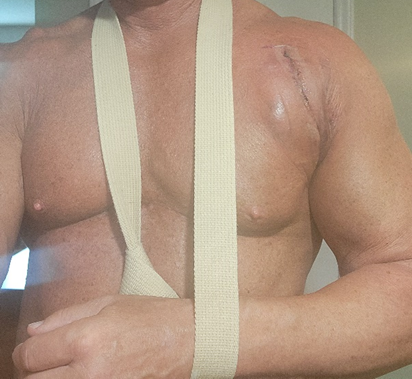
(2-week mark still considerable swelling)
One Month Post-Surgery: At the one-month mark, I was making significant strides in my recovery. I continued with physical therapy diligently, and my range of motion improved considerably. I could finally start to see the light at the end of the tunnel, although I knew I had a long way to go.
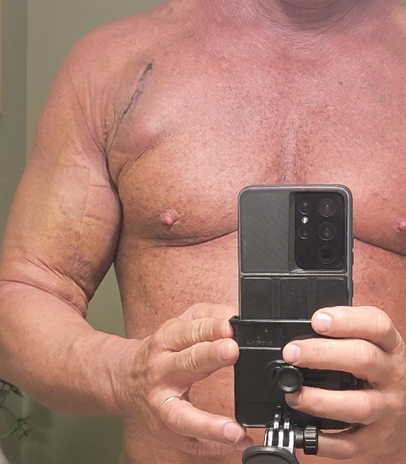
(One month was still swelling but I continued to train one side of my body and legs. Something about the synergy of muscles I think keep muscles that I couldn’t train from atrophying)
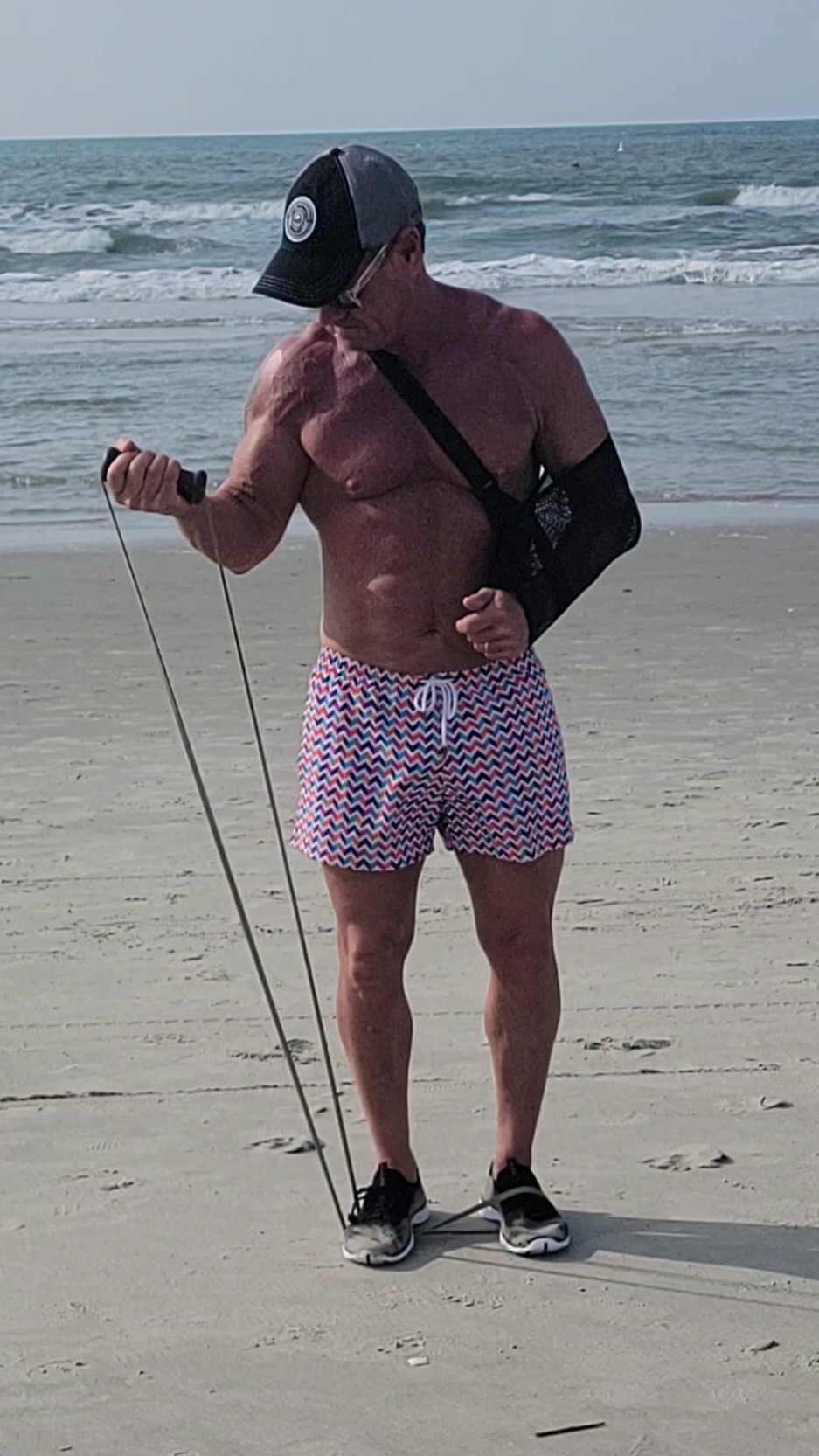
(two month mark, working out one side of my body)
Month 4: Reflecting on My Journey: Now, at the four-month mark, I can say that the road to recovery has been a rollercoaster. The seriousness of my injury was not something to be taken lightly, and the surgery was just the beginning of a challenging process. However, I've learned some invaluable lessons along the way.
Recovery is not linear. There were moments of frustration and setbacks, but perseverance was key. It's crucial to trust the process and listen to your healthcare team.
Support matters. My family and friends played a crucial role in my recovery, providing emotional and physical support when I needed it most.
Patience is essential. Healing takes time, and progress can be slow. Celebrating small victories along the way kept me motivated.
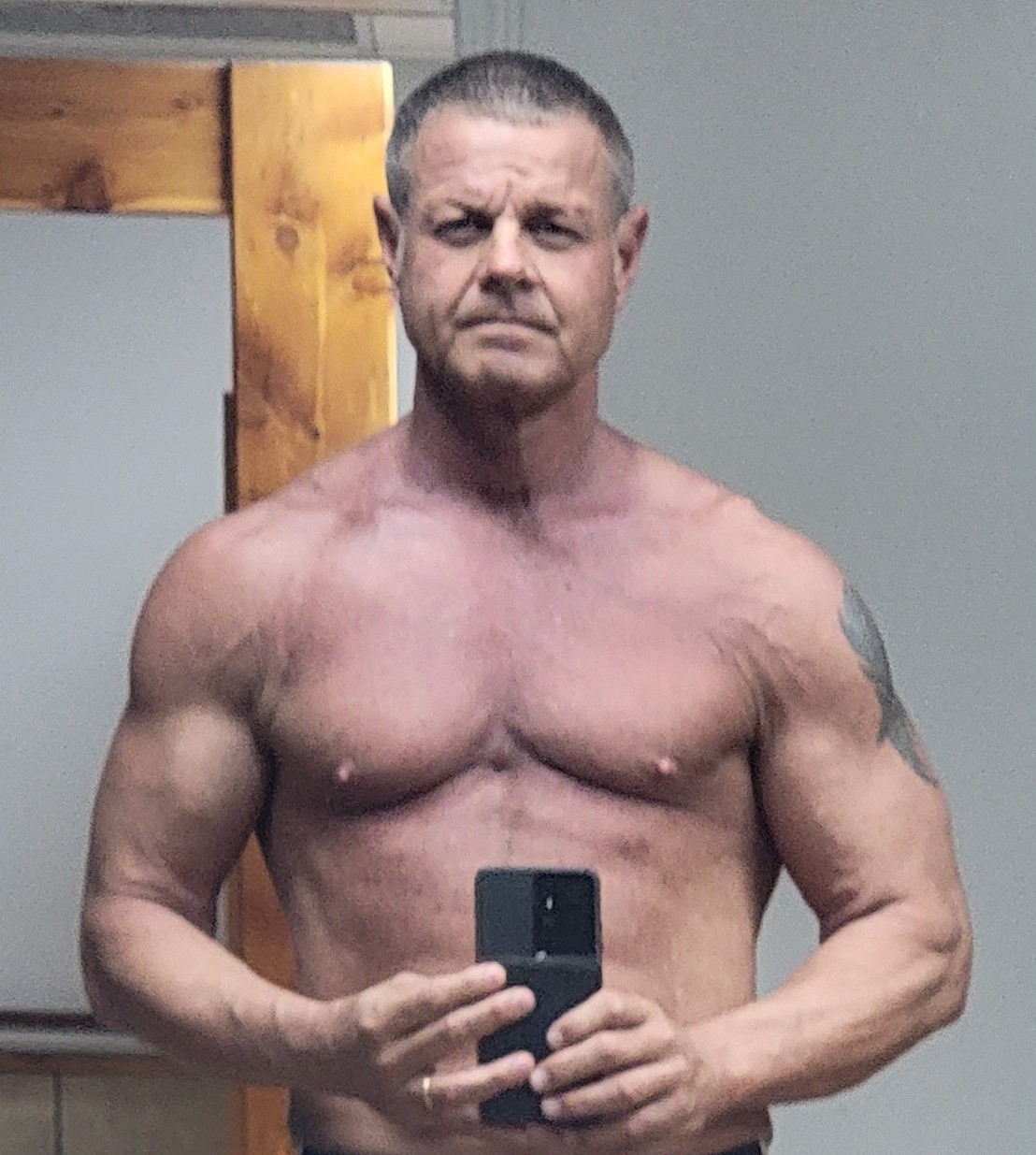
(4 month mark)
Progress and Hope: During the darkest moments of my recovery journey, I saw my bodyweight plummet to a mere 172 pounds. As I reflect on the past four months, I'm now tipping the scales at just over 184 pounds, though admittedly, it's not the lean muscle mass I once had. The road ahead remains long and challenging, but I'm determined to return to my pre-injury weight of 200 pounds and, importantly, regain the strength and definition that have eluded me. It's an ongoing process, and I understand that it won't be without its trials, but I refuse to go quietly. I'm ready to fight tooth and nail every step of the way, striving to achieve a level of fitness even a 55-year-old can aspire to attain.
The Role of BPC-157 in My Recovery:
In my journey towards recovery from a severe pectoral muscle injury, I discovered a remarkable ally in BPC-157, also known as Body Protecting Compound 157. This peptide, though relatively unknown to the mainstream, played a pivotal role in expediting my healing process. BPC-157 is a synthetic peptide derived from a protein found in human gastric juice. It has gained attention for its potent regenerative properties, particularly in aiding the recovery of tendon and muscle injuries.
BPC-157 functions by stimulating the body's natural healing mechanisms. When administered, it promotes angiogenesis, the formation of new blood vessels, and enhances the production of growth factors and collagen. In the context of tendon injuries, like my ruptured pectoral muscle, these mechanisms are invaluable. The increased blood flow and collagen production accelerate the repair of damaged tissue, while the growth factors stimulate the body to generate new cells, further aiding in the regeneration process.
I incorporated BPC-157 into my recovery regimen administered through targeted injections near the injured area, it worked synergistically with the surgical repair to promote tissue healing and minimize scar formation. While the seriousness of my injury would typically entail a lengthy recovery, the inclusion of BPC-157 seemed to catalyze the healing process, allowing me to regain strength and mobility more swiftly than anticipated. Though not a magic cure-all, BPC-157 served as a valuable adjunct in my journey towards recovery, highlighting the potential of emerging therapies in the realm of sports medicine and injury rehabilitation.
In Conclusion: In closing, my journey from a ruptured pectoral muscle to recovery has been nothing short of profound. I share my story not only to emphasize the seriousness of this injury but also to underscore the vital role that patience, perseverance, and a strong support system play in the recovery process. While I continue to work towards a complete recovery, I am genuinely grateful for the progress I've made thus far, knowing that each step brings me closer to reclaiming the strength and vitality I once enjoyed.
Closing Thoughts: I fervently hope that none of you, dear readers, ever have to experience the excruciating pain of a torn pectoral muscle. However, should you find yourself in such an unfortunate situation, I implore you to seek professional help immediately. Choose a doctor who not only possesses the knowledge but also embodies the principles of fitness and aesthetics – someone who genuinely cares about your well-being.
Approach the journey with the understanding that this injury is but a temporary speed bump in your path, one that will pass with time and dedication. Embrace the lesson I've learned: pride and age should never be intertwined. No one truly cares about how much you lift. I get it; I missed the strength of my youth too. But what adversity has taught me is the importance of returning to my bodybuilding roots – slow, deliberate repetitions, lighter weights, and truly feeling the muscles engage.
Remember, you can build impressive biceps with nothing more than a Campbell's Soup can if you perform the exercises correctly. I found myself revisiting my old Mike Mentzer training books, reevaluating my approach to fitness moving forward.
The most regrettable aspect of my journey was realizing the injury was entirely avoidable. In retrospect, there are far more effective exercises for developing chest muscles than the bench press. The Bible warns against pride and a haughty spirit, as well as extols the glory of young men and their strength. I may not be young anymore, and it was undoubtedly pride that led to my injury. Yet, I am genuinely grateful for this experience. It has imparted a valuable lesson: I am not indestructible, and as a seasoned lifter, I must train smarter, not harder.
In 6 months I will post another update and when May 2024 roles around I hope to update as fully recovered and surpassing where I was preinjury.
In closing, I extend my heartfelt wishes for your well-being and offer a final thought – God bless.
Rodney
Philippians 4;13
“I can do all things through Christ, who strengthens me”
